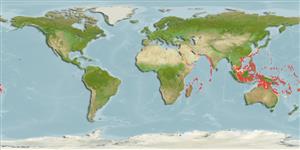Common names from other countries
Environment: milieu / climate zone / depth range / distribution range
Ecologia
marinhas associadas(os) a recifes; intervalo de profundidade 8 - 55 m (Ref. 10671). Tropical
Indo-West Pacific: Mozambique to the Philippines.
Tamanho / Peso / Idade
Maturity: Lm ? range ? - ? cm
Max length : 30.0 cm SL macho/indeterminado; (Ref. 48637)
Espinhos dorsais (total) : 5; Raios dorsais moles (total) : 28 - 30; Espinhos anais: 2; Raios anais moles: 28. Fresh specimens with yellow caudal fin and blackish peduncular plate; preserved specimens uniform grey in color and dark fins (pectorals pale). Oblique groove on side of snout below nostrils, its length about equal to length of naked area enclosing nostrils (Ref 9808).
Inhabits coastal to outer reef slopes, usually swimming along upper edges of drop-offs in small schools (Ref. 48637). Descends from the water column to the reef front to be cleaned by Labroides dimidiatus (Ref. 4974). Feeds on benthic algae (Ref. 3145). Forms aggregations, feeding on zooplankton well above the bottom over or in the immediate vicinity of reefs. Males exhibit rapid and striking changes in color pattern during courtship (Ref. 10671).
Life cycle and mating behavior
Maturities | Reprodução | Spawnings | Egg(s) | Fecundities | Larvas
Randall, J.E., 1994. Unicornfishes of the subgenus Axinurus Perciformes: Acanthuridae: Naso), with description of a new species. Copeia 1994(1):116-124. (Ref. 10671)
Categoria na Lista Vermelha da IUCN (Ref. 130435)
CITES (Ref. 128078)
Not Evaluated
Ameaça para o homem
Harmless
Utilização humana
Ferramentas
Relatórios especiais
Descarregue XML
Fontes da internet
Estimates based on models
Preferred temperature (Ref.
115969): 25.2 - 28.9, mean 27.6 (based on 388 cells).
Phylogenetic diversity index (Ref.
82804): PD
50 = 0.5000 [Uniqueness, from 0.5 = low to 2.0 = high].
Bayesian length-weight: a=0.01862 (0.01050 - 0.03303), b=3.05 (2.90 - 3.20), in cm Total Length, based on LWR estimates for this species & Genus-body shape (Ref.
93245).
Nível Trófico (Ref.
69278): 2.6 ±0.29 se; based on food items.
Resiliência (Ref.
120179): Médio, tempo mínimo de duplicação da população 1,4 - 4,4 anos (Preliminary K or Fecundity.).
Fishing Vulnerability (Ref.
59153): Low to moderate vulnerability (27 of 100).
